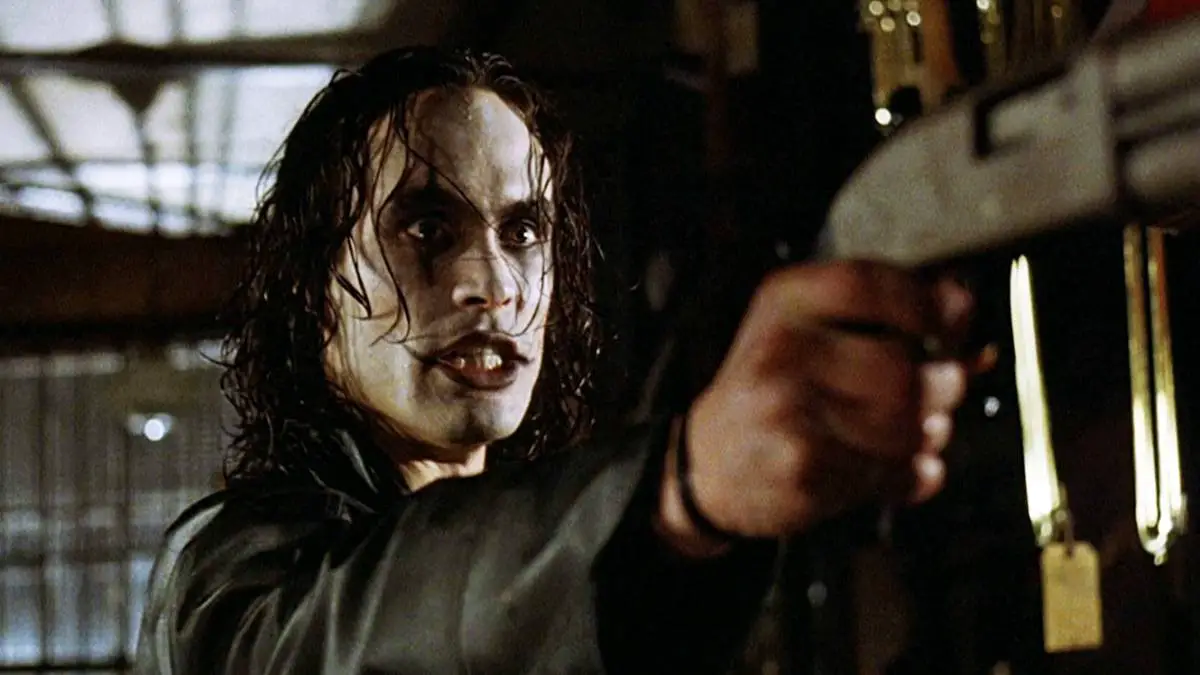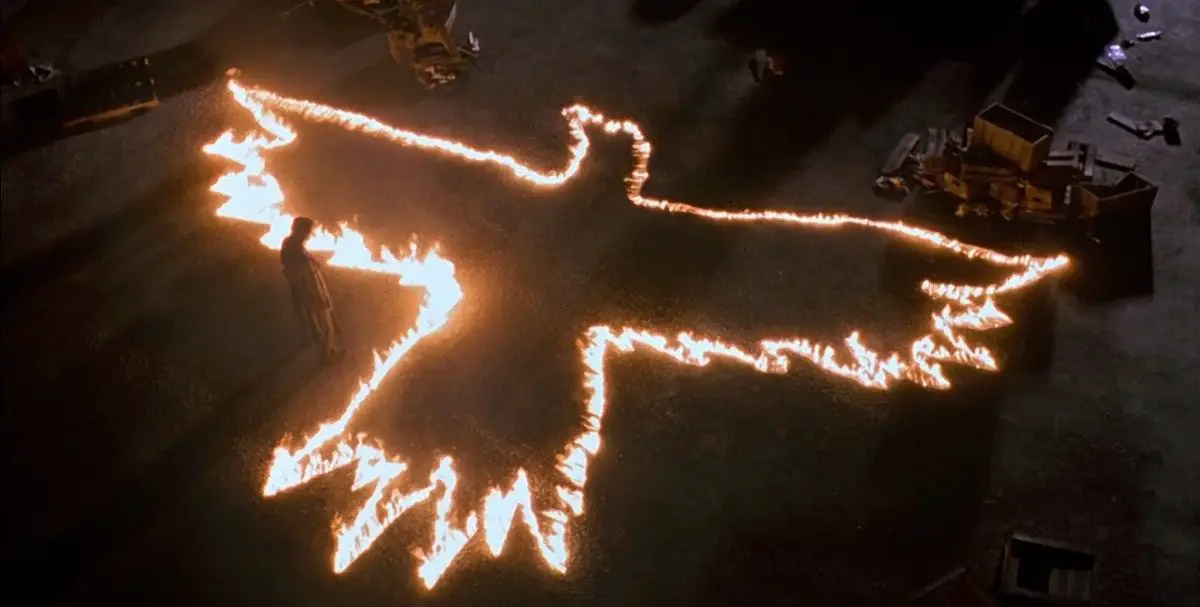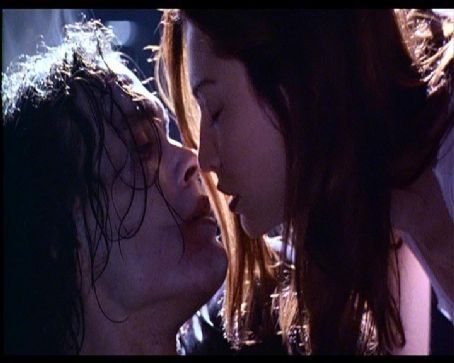The artists people are interested in have something eating at them. Elvis. What was eating at that guy? Why did he have to sing like that and move like that? Jerry Lee Lewis, what was eating at him? What was eating at Hank Williams? Johnny Lydon? Something was. So the idea is: how do you manage that thing that’s eating at you, without letting it eat you? ‘Cause that’s what it wants to do. The thing that’s eating at you, wants to eat you. And so your life is…how do you keep that from happening? — Bruce Springsteen, Guardian interview, 2009
It is cruelly ironic that The Crow, a film based on a comic book that deals with the unfairness and trauma of unexpected death, became famous for an unfair, unexpected death of its own. The circumstances of lead actor Brandon Lee’s accidental demise have been well documented. But for James O’Barr, author of The Crow comic book (the original source material for the film), this was the second death that had occurred in relation to The Crow (one before the comic was written, the second during the making of the film) and he couldn’t help but feel that responsibility, either fairly or unfairly, weigh down on his spirit. O’Barr has said: “At the time, the same guilt and self-hatred swelled again in my soul (“If I’d never written the f–king thing…”), threatening to drown me, suffocate me. It was the help and compassion of Brandon’s fiancé, the beautiful Eliza Hutton, that guided me to shore.” [1]
But before the shore there was a very stormy sea that had to be navigated. The Crow is James O’Barr’s course through such pain and trauma. So before we can appreciate the film fully, we need to understand what was eating at James O’Barr and drove him to create The Crow in the first place. What was the death before The Crow? And who was the ‘Girl Who Was Shelly?’ [2]
No Justice In the Real World
Sometimes the most life-changing, permanently wounding events can come from the most innocuous beginnings. In the case of James O’Barr, he had forgotten to pay for his car insurance. Rather than risk driving and getting flagged down, he asked his then-girlfriend, the lady who was to become known in time by Crow cultists as ‘The Girl Who Was Shelly,’ to drive over to his place and pick him up. It was an innocent, everyday request that would have disastrous consequences.
Unfortunately, she didn’t even make it to her car. A drunk driver made sure of that. ‘The Girl Who Was Shelly’ sadly died on the spot, a pointless, wasteful accident about which very little, perhaps nothing could make sense. Certainly, O’Barr’s reaction, to blame himself, was not logical; it was the driver’s fault, after all. But overwhelming grief does not take the air with logic. From this point of view, O’Barr’s self-blame is perfectly understandable, if not fair or correct. As he put it himself, “If I’d only paid my car insurance…if I’d only waited ten more minutes to call…if I’d only said, “I’ll just see you tomorrow, punkin!” If, if, if…there was nothing in my future but nothingness.” [3]
“The thing that’s eating at you, wants to eat you,” said Bruce Springsteen. “And so your life is…how do you keep that from happening?” For James O’Barr, you kept yourself from being consumed by transferring the pain into art and transforming it in the process:
I’d hoped by putting all my murderous fury into ink on paper that somehow, magically, all the pain, hurt, and self-destructive behaviour that followed would dissolve… Shelly’s death had turned me into a monster under my own skin, hidden by a stoic face of normalcy. Like a mad cartographer, I charted an ink-on-paper landscape swept in rage. If there was no justice in the real world, I would invent some. [4]
If you’re reading this, then chances are that you know the story of Eric and Shelly like the back of your hand, so I won’t bore you by recounting more of it here. The Crow comics were published in 1989 and acquired a passionate cult audience. But that wasn’t the end of the story. The pain would not just go away. Instead, it would find itself pressed into the soft surface of celluloid.

The Taming Of The Dark
In a way, it is as much a surprise that The Crow was optioned as it was that it was completed after Brandon Lee’s death. After all, it was a small, cult comic book, not a giant of the genre like The Amazing Spider-man or Superman, and it was an extremely dark comic book at that. What brought The Crow to Hollywood’s attention?
We have Tim Burton to thank, as it happens.
In 1989, Burton’s vision of Batman was a surprising and substantial success, being (at that time, since surpassed) the fifth-highest-grossing film of all time and earning an Academy Award to boot. The success of the film proved there was a market for darker comic book films, albeit a darkness tempered by a highly stylised production, an upbeat Prince soundtrack and Jack Nicholson doing what he does best—being Jack Nicholson—as the Joker. Hollywood went scurrying after any comic book it could find with a dark heart it thought it could tame. The Crow fit the bill.
James O’Barr received at least one offer by the time Issue 3 was released, but it was a pitch by writer John Shirley and producer Jeff Most to which O’Barr acquiesced, with a rewrite of the script made by David J. Schow. All that was needed was a director.
In the meantime, the backlash against darkness had begun. Tim Burton had released sequel Batman Returns to much criticism, mainly of its darker tone compared to that of its predecessor. There was no Prince or Jack Nicholson this time to provide balance, and neither the critics nor the audience had much time for the sullen, macabre leftovers.
The negative reaction to Batman Returns led to a rethink by studios as to what a comic book film should be—i.e., what would be the most commercial way to proceed. As a result, we were ‘rewarded’ with Joel Schumacher’s 1995 neon-lit, unsubtle, kiddie-targeting Batman Forever, a film that talked the talk but had all the substance of a Happy Meal. The Crow was lucky, in its way. If it had been pitched to the studio just one film later, after Batman Returns, the likelihood is that no-one would have touched it.
Transmitting A Broken Heart
What The Crow does share with its movie brethren of the time is its highly stylised approach. Whereas Tim Burton went for a highly exaggerated gothic-meets-pop-art approach, and Schumacher eliminated the goth and the art and made the pop into a ‘pop music video,’ The Crow found a way to combine the two. It very successfully took the highly stylised gothic imagery of Batman and gave it the feel of a very well-made pop video by utilising punchy, quick editing and a bold use of its colour palette (think oil over watercolours). It’s no wonder the goth, metal and industrial communities clutch the film to their hearts.
Perhaps it’s no surprise that the pop video feel was prevalent. Director Alex Proyas had not made a feature film prior to The Crow. Primarily, he had directed music videos in his native Australia, most notably for Crowded House and INXS (not the most industrial or gothic of bands, it must be said). Perhaps with the late ’80s trend towards slicker, MTV-inspired productions (see Nightmare on Elm Street 4), Proyas was offered several scripts before he landed on The Crow. He wasn’t impressed by the initial script, but once he read the comics he felt a sympathy for the project, as he told Paul Rowlands of Money into Light:
I looked at the comic and I thought it was really cool. I was really inspired by imagery in the comic book, and by the story, which I thought was clear, clean and simple. I felt that as a filmmaker I could create this world… I’m very emotionally connected to stories of lost loves or loved ones. I lost my mother in my teens. I was really touched by this idea of a guy being separated from his love through death and has to somehow reunite by crossing that bridge.
Curiously though, Proyas’ initial thoughts on production were not focused on the sumptuous charcoal blacks and smudged greys and fiery oranges that transmit Eric Draven’s broken heart onto his Detroit surroundings. Instead, taking his cue perhaps from the somnambulist in The Cabinet of Dr Caligari, he wanted to make the film in black and white. “The comic book is essentially black and white,” Proyas told Rowlands. “The graphics of the comic book inspired a German Expressionist style.” Whilst this would have been an interesting experiment, it would have taken a lot of the heart from the film, with the colour palette giving expression to the trauma and fury at the heart of Eric and The Crow overall.

A Soundtrack Of Empathy
The ’90s seemed to see a revival in people buying soundtrack albums, perhaps made hip again by the tasteful, well-selected cool of Quentin Tarantino’s collections of pop, rock, and soul. Along with Twin Peaks, the Pulp Fiction soundtrack seems to define the TV and cinema sounds of the ’90s. But they are not alone.
While Pulp Fiction’s soundtrack entered the mainstream consciousness, The Crow soundtrack spoke to those in the metal and industrial rock scenes, much like the film itself. The amount of metalheads I came across in my younger days who had the soundtrack in their collection, next to their Machine Head and Pantera albums, is unreal. Therefore, it’s fair to say that the soundtrack acted out the pop video visuals of the film for its audience and is therefore one of the seminal movie soundtracks of all time.
When reflecting on the soundtrack, it is reasonable to remember that Eric Draven is a deceased rock star. The images of leather and stark black-and-white face paint, the furious heat of fires and gunshots, the gothic gravestones and the church of the climax—a simple orchestral accompaniment would not suffice. The soundtrack needed to reflect the audience it was speaking to, intentionally or otherwise.
Appropriately for a former director of pop videos, Alex Proyas told Rowlands that he wanted “the songs to be part of the narrative of the movie. I didn’t just want a couple of tracks playing over the end credits. I have facetiously described the movie as a musical on occasion, and it kind of is. The music often drives the story.”
Whilst I wouldn’t necessarily agree that the music drives the story, it certainly compliments it. More than that, and perhaps more importantly, it is empathetic to Eric’s internal trauma, giving a sensual understanding of his pain to the audience through the tension and melancholy of its robotic, punishing industrial rhythms and expression of violent longing. When Trent Reznor yells, “They keep calling me!” on Nine Inch Nails’ cover of the Joy Division classic ‘Dead Souls,’ you can feel the subliminal whispers in Eric’s mind, pushing him onward in his murderous quest for vengeance.
Even more interestingly, “they keep calling me” ties in very well with The Crow’s creators. James O’Barr used the comic book to transfer the pain of grief and to arrive at an expression of some kind of justice, whilst Proyas would have be the unenviable task of having to complete a film that had already killed one of his close friends.
“Forgiveness is for the forgiver”
In the aftermath of the death of Brandon Lee (with whom the director had become very close during production), Proyas had no intention of continuing work on the film. It wasn’t the technical logistics that presented a problem; these could be overcome, and often were (a double would stand in for Lee on some later shots that were needed, his face obscured out of necessity). It was the burden of continuing a project that had claimed his friend and would present reminders of his absence everywhere. It could not, must not go any further, thought Proyas.
But The Crow would not let him be. Brandon Lee’s family wanted to see the film completed, perhaps so that he wouldn’t be forgotten by the larger public, and so that a legacy could be left (the film was certainly successful in this respect).
The guilt and regret involved in continuing would drive and torment Proyas, who confirmed to Rowlands that the Lee family’s desire that the film be completed was “literally the only reason I went back to the film several months after the accident.”
Yet there was no redemption, no catharsis in completing the film. Describing himself as being in “a haze” during the completion of the film, Proyas told Rowlands that that he “can’t actually say much about the film aesthetically in any way because I just don’t remember it very well. I’ve pretty much put it from my mind because of the pain from the experience that happened.”
It seems like repression, or a form of psychic self-defence. How do you stop yourself being eaten by that which wants to devour you? One way, quite understandably, is to push the devourers, those painful emotions or memories, back into the dark recesses of the mind, not allowing them the air or time to breathe and gather strength and power. I can’t even begin to imagine how Proyas must have felt completing the film.
The Crow’s creator, though, I am happy to say, eventually reached a kind of resolution, a truce with the furies.
“Today I now understand that ‘forgiveness is for the forgiver,’” wrote James O’Barr in his introduction to the 2011 special edition of The Crow comic book. “Eric (and I) had to forgive ourselves. Part of this entailed returning to a gravesite I hadn’t visited in decades. The other part was accepting the death of my friend Brandon Lee.” [5] Sometimes, forgiveness is the first step. All else may then follow.

At the end of The Crow, Eric is reunited with Shelly at their graves. He has slumped at her grave; his last breaths have been taken for real now. No more resurrection. No more time to put things right. Shelly appears out of the darkness as an angel and strokes his hair lovingly. They share a kiss before the scene dissolves to the pair’s graves, no bodies in sight, but tidy and neat, the crow itself perched on one of the stones, gifting Shelly’s engagement ring to Shelly to give her hope, to let her know that she is not alone. It is a beautiful, tender moment, proof that with forgiveness can come love and redemption.
In the film, it is Sarah who gets the last word. I think it’s only fitting that James O’Barr gets the last word here: “No one ever really dies as long as they are loved. And I know that, somewhere, ‘Shelly’ is smiling.” [6]
[1-6] O’Barr, James. The Crow (Special Edition). New York: Gallery Books, 2011



